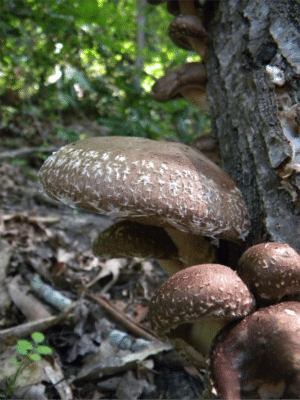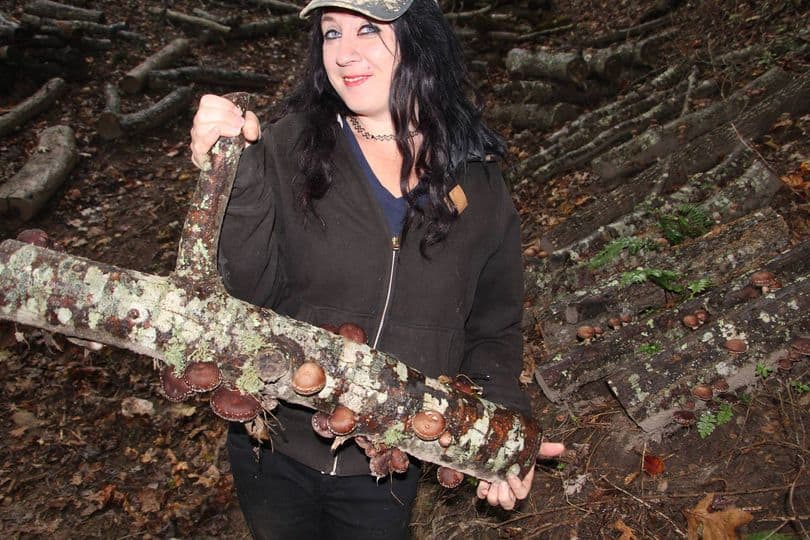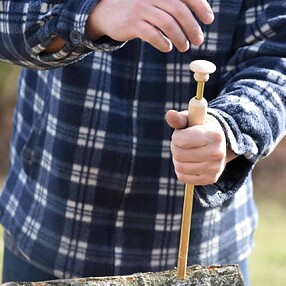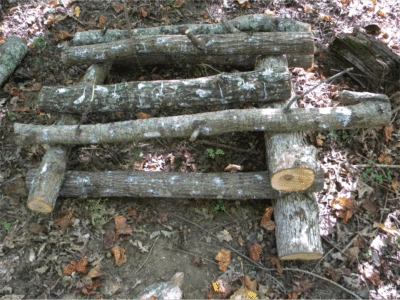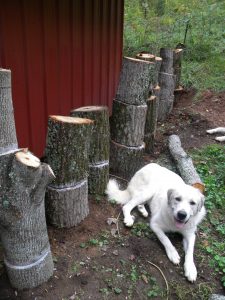Over the years, my husband and I have grown hundreds of pounds of Shiitake mushrooms using logs from our woodlot. These mushrooms provide extra protein and nutrients to our diet as well as some medicinal benefits.
What are Shiitake mushrooms?
The Shiitake is a mushroom that is native to Japan. They play a significant role in Japanese cuisine.Shiitakes range in color from light brown to a deep rich chocolate color. They can be grown in practically any climate. You can even grow them inside on logs or substrate blocks.
Growing Methods
Plugs and Sawdust Spawn
The two most common types of spawn are wooden dowels and sawdust.Wooden Dowels
ProsCons
- Easy for beginners
- Lower shipping costs
- Good for those that plan on inoculating less than 25 logs.
- It takes longer for logs to colonize with spawn and fruit.
- Higher cost per log compared to sawdust spawn if you inoculate more than 25 logs.
Sawdust Spawn
ProsCons
- Inexpensive
- Produces mushrooms fast
- You can often find more varieties of Shiitake spawn in sawdust form.
- Requires an inoculator tool. This is essentially a spring-loaded tube that allows you to shoot spawn into a pre-drilled hole.
- High shipping cost if you are only ordering a bag or two.
- A single bag inoculates 20-25 logs. This is often more than the average homeowner wants to do or has space for.
Sources For Spawn
There are a lot of choices for mushroom spawn. I recommend going with a supplier that is within 1500 miles, so spawn is not in the mail for a long time.Mushroom spawn is not always in stock at all suppliers. If you intend on placing a large order, you may have to wait a week or two.
Buying more helps take the bite out of shipping costs. If you have friends or family who want to grow mushrooms, it is to everyone’s benefit to split an order and pay less shipping. You can often get significant discounts on each bag if you buy 6 or 12.
Here are a few suppliers I recommend:
Mushroom Mountain
Fungi Perfecti
Field and ForestThere are a lot of smaller suppliers on Etsy as well. I recommend reading customer reviews before purchasing.
Choosing Your Variety
It can be confusing to new mushroom growers when they look at a catalog and see 30 different kinds of Shiitake spawn listed. On our farm, we grow cold, wide, and warm weather Shiitakes so we can enjoy a long and regular harvest season.
Cold Weather Shiitakes
These typically fruit when temperatures are 45-65F. We enjoy the thick meaty caps that colder varieties produce. Growing cold-weather varieties help you to produce some food during a time of year when not a lot will grow outdoors.Wide Range Shiitakes
A wide range Shiitake will fruit at 55-75F. This is your best bet if you want a reliable producer for many different seasons.Warm Weather Shiitakes
In some areas, outside temperatures can reach the high 80s or even 90s. If you want to grow Shiitakes during the hot parts of the year, consider a few warm weather logs. Be warned that these logs will typically not fruit until temperatures reach 65F and often not until regular temperatures in the 70s.Specialty Varieties
You may read about Shiitake varieties that have been developed to grow “well” on types of wood that are typically not good choices. My husband and I have some experience with this that I think is important to share. We had a lot of smaller cherry trees on our property and wanted to use them for something besides just firewood. We tried a Shiitake variety that was supposed to do well on cherry. The results were mixed. While the Shiitakes did grow, we only got about half what we would expect per fruiting, and the logs only lasted a few years. If we had used Oak logs and did the same amount of work, we would have been a lot better off.
I am not saying that there are no specialty strains out there that will work; however, I encourage those who are just getting started in the world of mushroom growing to stick to some variety of Oak if growing Shiitakes on logs.
Log Inoculation
The highest quality Shiitakes are grown on logs. The minimum diameter for Shiitake logs is 4 inches. You can use as big a diameter as you want, but most people stick to 4-8 inches due to the weight of the logs. Smaller logs will fruit faster than larger logs, but they will not produce for as many years.
If you cut your own firewood, you may sometimes find yourself with a lot of limbs after cutting up the main trunk of a tree. Limbs often make great Shiitake logs.
You can also ask a local woodcutter to put together an order of logs for you. Purchasing larger logs is often less than the cost of a similar amount of wood cut and split. Just be sure to let them know that you want logs that are “green.” If the wood has been sitting for more than 6-8 weeks, then it may be contaminated with other fungi and interfere with your Shiitake spawn taking to the wood.
What wood can you use to grow Shiitakes?
Oak works best for Shiitakes but they have been grown on other species. Some spawn companies have developed varieties that will produce on other types of wood. For best results, stick to Oak species.How many years will a log produce?
[caption id="attachment_619458" align="alignnone" width="810"] Author with shiitake log[/caption]The lifespan of a Shiitake log depends on a lot of factors. We have some logs that produced for ten years, but they produced fewer Shiitakes as they grew older, and the wood broke down more due to the fungal growth. Here are the factors that will influence the lifespan of your logs:
-
Larger diameter logs will produce mushrooms longer.
-
Wood density is important. On our property, we had some stunted Chestnut Oak trees. At 80 years old, they were only 12 inches in diameter. These Shiitake logs lasted for more than a decade due to the high density of the wood. It simply takes dense wood longer to break down.
-
Species of wood used. While there are Shiitake strains that will grow on various wood species, some species are better than others. This is why it is important to make sure you match up the wood you have with a strain that is known to do well on the wood you have.
-
How often the log fruits. Outdoor grown Shiitakes on logs where conditions for fruiting happen a lot will produce a lot of mushrooms in a shorter time. So while the lifespan of the log may be shorter, you still get a lot of mushrooms. Forcing your logs to fruit is a common practice. The more often you do this, the shorter the lifespan of your log.
How many pounds will I get per log?
It is hard to say an exact range. I have read many different estimates and found them to be questionable based on our experience over the years. Many of the factors that influence how many years your log will produce also affect how many pounds you get over the life of the log.I can tell you that it is worth it to grow Shiitakes on wood and that you will be surprised how many meals a single log provides over the years.
List of Supplies Required For Mushroom Log Inoculation
[caption id=" align="alignright" width="286"] Photo courtesy of Field and Forest[/caption]- Drill
- Mushroom Spawn (Dowels or Sawdust)
- Inoculation Tool
- Cheese or Soy Wax
- Old pot and something to heat up the wax
- Small paintbrush or something to dab wax on with.
How to inoculate a log
1. Drill out holes in a diamond pattern. You will need a 7/16" drill bit. Drill holes about an inch deep. 2. Plunge your inoculation tool into your bag of spawn. Pouring some into a pan is helpful since it is easy to put a ton of holes in your bag.-
Carefully place the tool over the drilled-out hole and push the plunger to put spawn into the hole.
-
Repeat until all holes are filled.
-
Seal holes with a thin layer of wax.
[caption id=“attachment_619456” align=“alignnone” width=“300”]<img class=“wp-image-619456 size-full” src=“https://peakprosperity.com/wp-content/uploads/2021/10/47-300x400-1.png” alt="“holes drilled in log” width=“300” height=“400” /> Drill holes[/caption]
Incubating Logs
[caption id="attachment_619508" align="alignright" width="400"] Log cabin method of stacking[/caption]Logs should be set aside in a shady place and occasionally watered for best results. If you live in a dry area, you will need to water them regularly. Logs mustn’t dry out completely. Keeping logs moist and out of the sun will lead to faster fruiting.
Stacking logs on top of each other can be helpful during the long incubation period because it helps them hold moisture better. When logs are colonized, you will start to see a white fungal growth at the end of your logs. At this point, you can stack them log cabin style or partially bury one end in the dirt to help keep them moist. Another common method is to lean logs against a central support. Make sure to leave enough room between logs for mushrooms to grow and to allow you to reach them when harvest time comes.
Wood Dowel Method
If you want to use dowels you will need a 3/8 drill bit. Drill holes in a diamond pattern. Tap dowels in using a hammer or rubber mallet. Seal with cheese or soy wax.Totem Method
[caption id="attachment_619453" align="alignright" width="225"] Totem method of stacking[/caption]You can grow Shiitakes by taking two pieces of wood that are similar in diameter and sandwiching spawn in between the two. We usually use a big nail or screw to make sure the two pieces are attached. This is a fast and easy way to get started growing mushrooms. The disadvantage is that these are practically impossible to move once you have them in place. We have a bunch under our barn where water drips down after rains.
Wedge Method
This method requires a saw and some nails or screws. Cut out wedges in logs that are lying on the ground. Stuff sawdust spawn into the gap, stick the wedge back in, and secure with a small nail or screw. Mushrooms will first grow out of the wedges but will pop up on other areas of the log as it becomes more colonized.[caption id=“attachment_619455” align=“alignleft” width=“400”]<img class=“wp-image-619455 size-full” src=“https://peakprosperity.com/wp-content/uploads/2021/10/67-400x300-1.png” alt="“Wedge method” width=“400” height=“300” /> Wedge method[/caption]
[caption id=“attachment_619454” align=“alignnone” width=“400”]<img class=“wp-image-619454 size-full” src=“https://peakprosperity.com/wp-content/uploads/2021/10/77-400x301-1.png” alt="“Wedge method” width=“400” height=“301” /> Wedge method[/caption]
Can other mushrooms grow on my logs even if Shiitakes are growing too?
Logs can become infected with other fungi, but this doesn't happen that often. Shiitake are very distinctive looking, so it would be very difficult to make a mistake and pick something else.Growing Shiitakes Inside or On A Balcony
Shiitakes can be grown on blocks of the substrate (this is essentially just a block of spawn that you could use to inoculate logs). There are plenty of kits out there that are designed to let you do just this. Here is a link to a good one from Field and Forest. All you need is a little bit of counter space and the ability to remember to water your block occasionally. Kits can yield a few pounds of mushrooms.Smaller Shiitake logs can be placed on balconies. You can soak the logs in a bucket to help them fruit or keep them watered.
Preserving Mushrooms
The easiest way to preserve mushrooms is by dehydrating them. If you want a good dehydrator without spending a lot of money, I recommend the Nesco Snackmaster. This dehydrator features a fan and various temperature settings.Shiitakes do give off a bit of an odor as they are drying, so you may want to set up your dehydrator in a room you are not in a lot and shut the door or use your garage. I would describe the odor as very earthy. Some people do not mind it.
You can dry mushrooms in an oven by setting them on cookie sheets or, ideally, mesh trays. This only works if you can set your oven temperature at 150 or less. The door to the oven should be left propped open slightly. I don’t like to use this method for several reasons. The oven method dries more unevenly and takes a long time.
Shiitakes will keep in your refrigerator in a brown paper bag for up to a month, so if you get a big crop, you have some time to get your dehydrator ordered.
Once dried, Shiitake mushrooms will stay good to eat indefinitely. Generally, the rule of thumb is that if you see mold on them or get wet, discard them. If we plan on storing dried mushrooms for a long time, we vacuum seal them and sometimes add a moisture absorber. If we plan on consuming them within a year, we use a jar with a rubber seal and a moisture absorber or two in the jar.
Canning Mushrooms
All mushrooms can be pressure canned. I have only done this once. It is time-consuming to can mushrooms, and they take up a lot of space and valuable canning jars. Canned mushrooms do not have the shelf life of dried mushrooms.
Pickling Mushrooms
You can pickle Shiitakes using canning jars placed in the refrigerator. They are not shelf-stable but will keep in the refrigerator for 1 week to several months depending on the recipe you use.
Here are a few recipes to try out.
Momofuku's Soy Pickled Shiitakes
Sauver Pickled Shiitakes
You can sell excess Shiitake mushrooms
Fresh Shiitakes can be sold to restaurants or at tailgate markets. Fresh Shiitake go for as high as $15 per lb during the winter months where I live. Expect to receive $8 and up for lb depending on who you are selling to and the season. Dried Shiitake can be sold via mail order. Selling to restaurants can be lucrative but it is tricky. You need to find restaurants that are willing sometimes to take flushes of mushrooms as they come in. If you have less than 10 lbs, it may not be worth anyone's time and you might be better off just drying them.Conclusion
Shiitake mushrooms are a great source of food that you can grow practically anywhere. If you prefer a mushroom with a lighter flavor, consider growing Oyster mushrooms.
Do you have experience with growing mushrooms? Let's discuss below...
This is a companion discussion topic for the original entry at https://peakprosperity.com/how-to-grow-and-preserve-shiitake-mushrooms/
